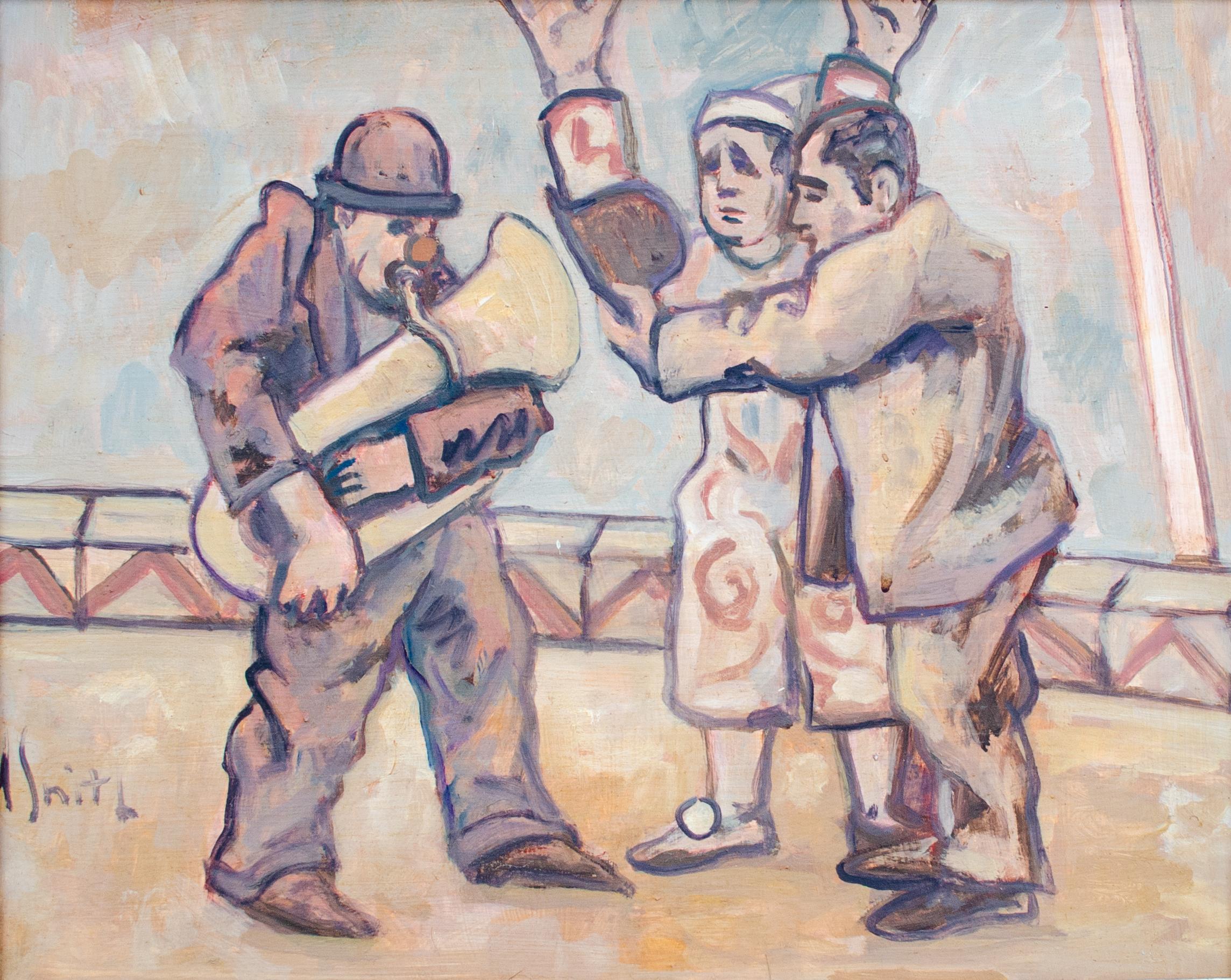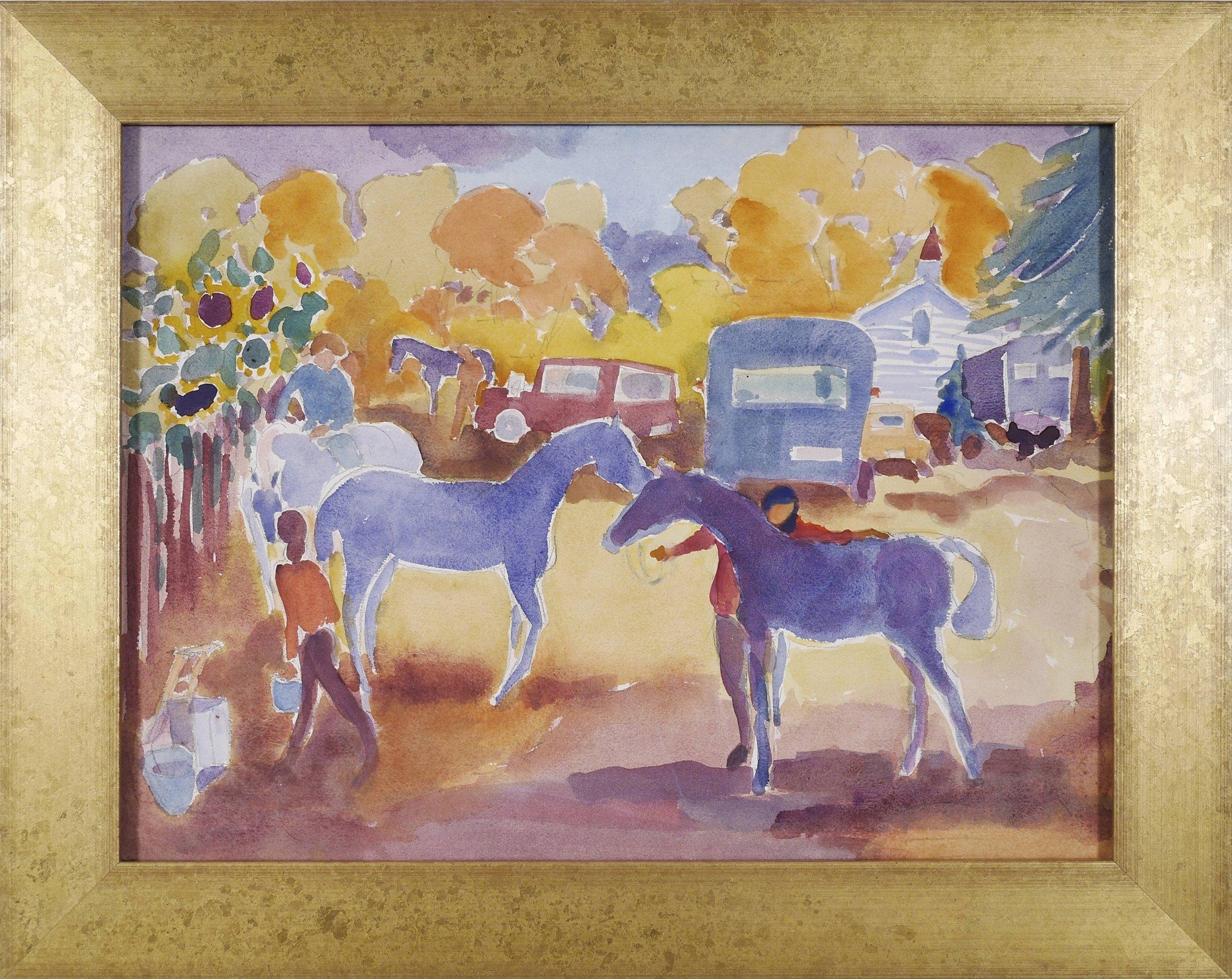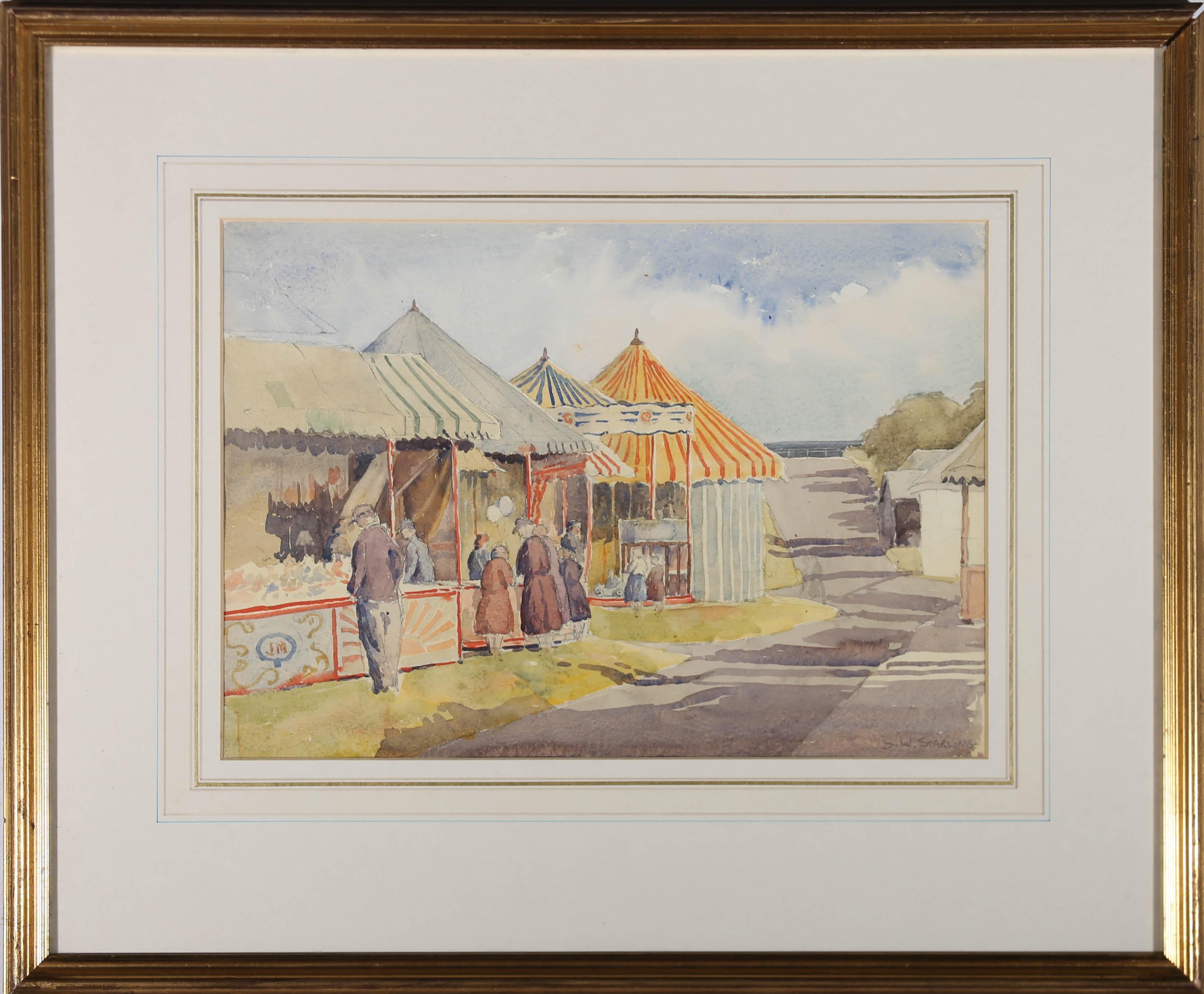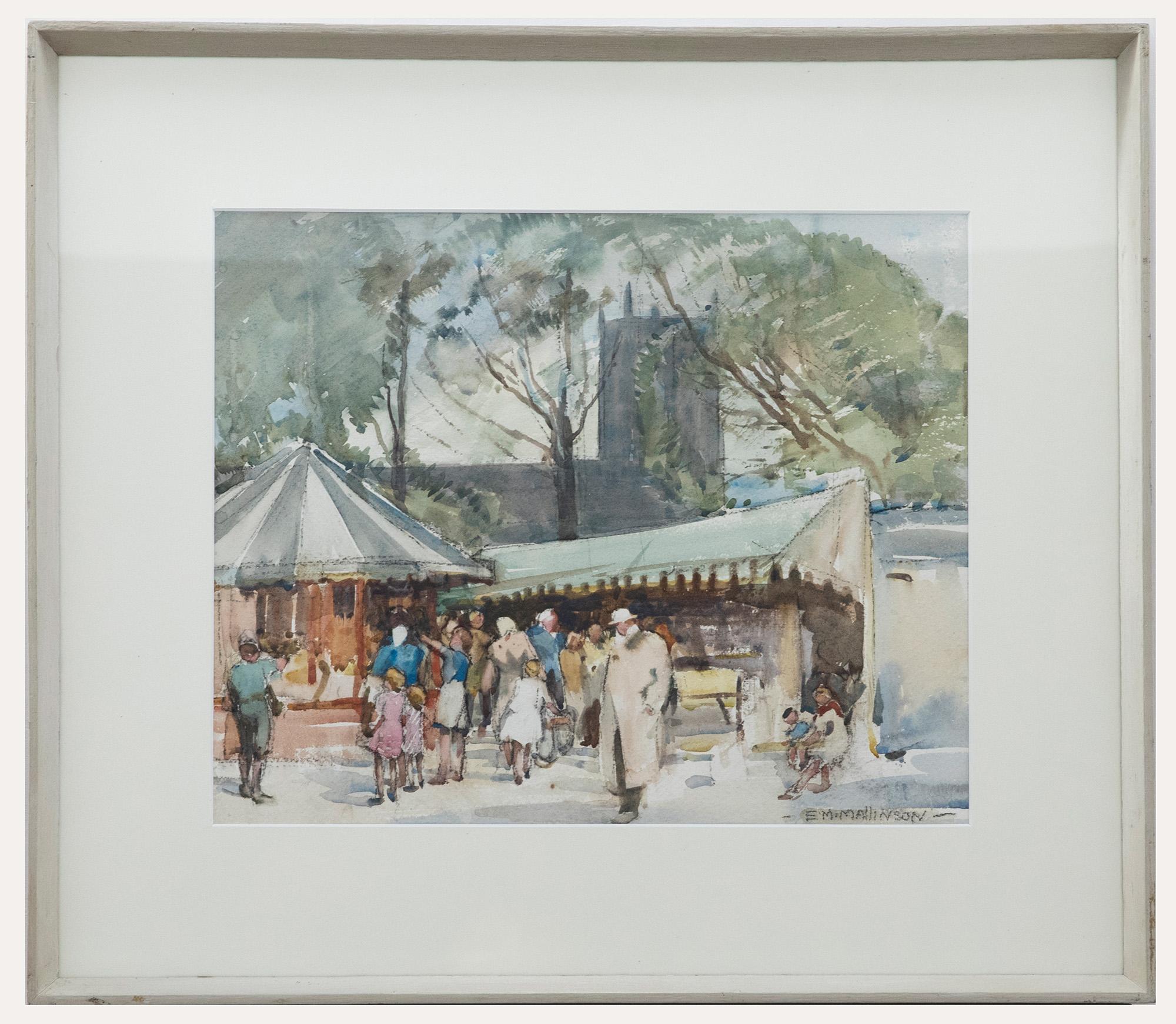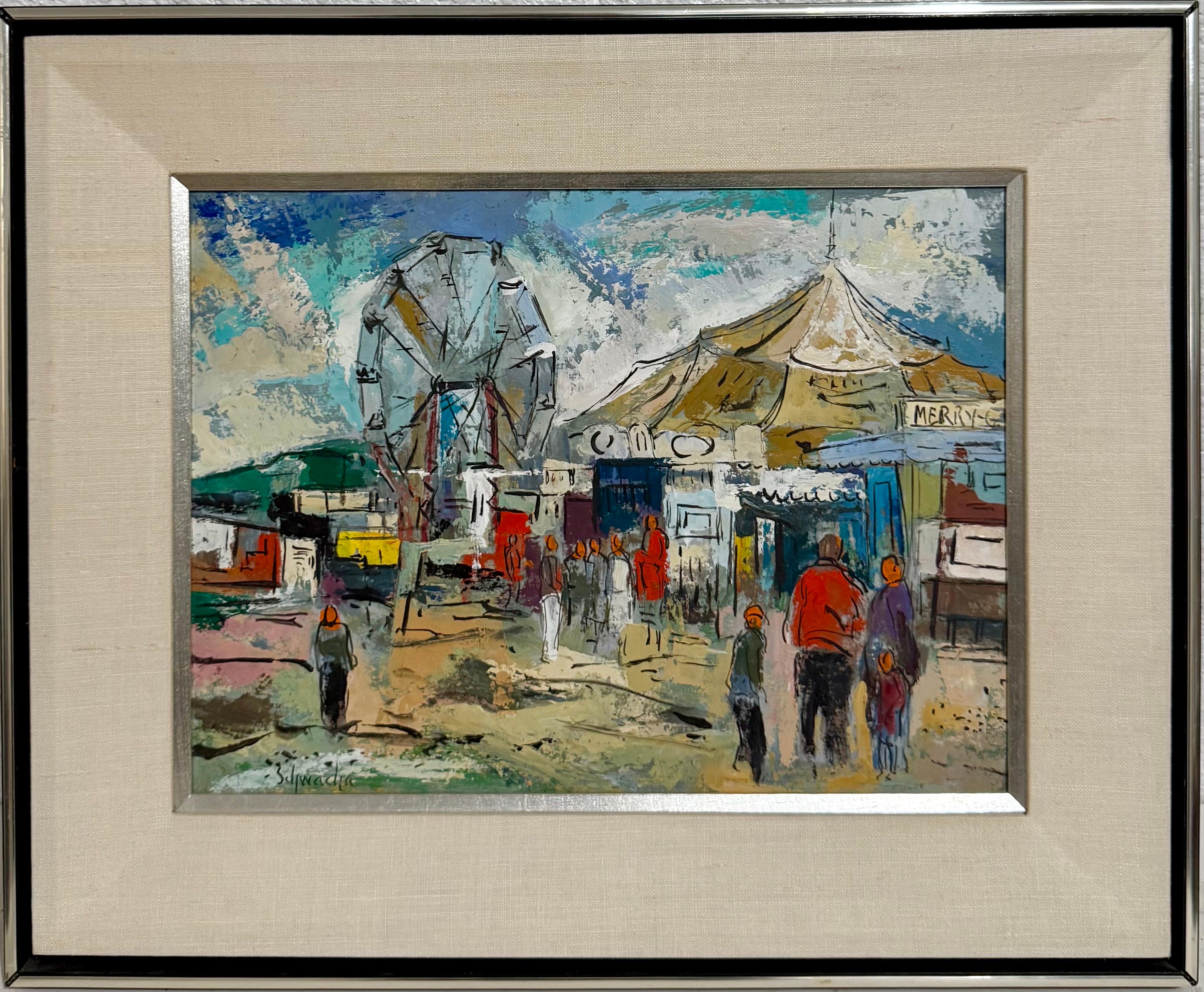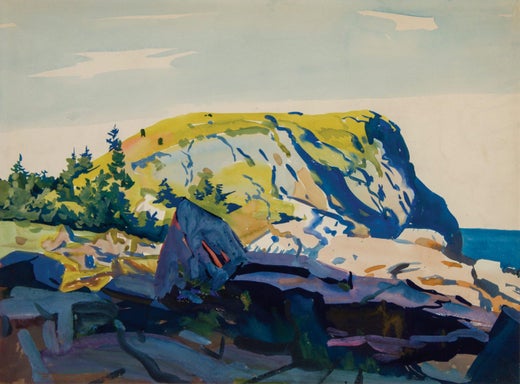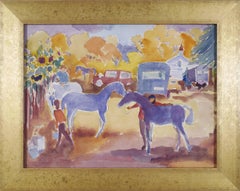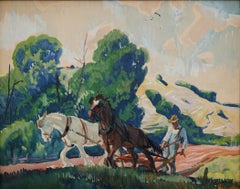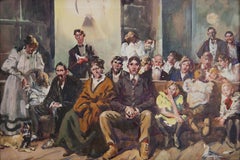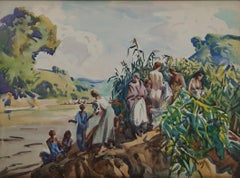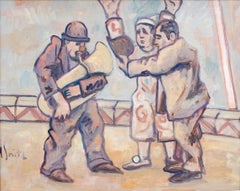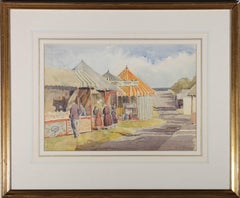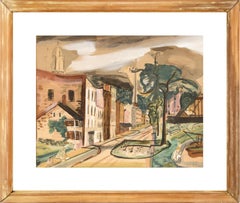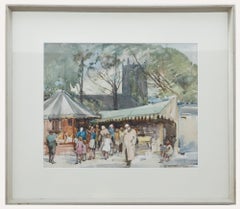Items Similar to Circus Lot at Toledo, Ohio, Early 20th Century Cleveland School Artist
Want more images or videos?
Request additional images or videos from the seller
1 of 11
Frank WilcoxCircus Lot at Toledo, Ohio, Early 20th Century Cleveland School Artistc. 1920
c. 1920
$9,000
£6,880.98
€7,925.50
CA$12,611.76
A$14,079.84
CHF 7,377.63
MX$172,351.10
NOK 93,695.93
SEK 88,343.36
DKK 59,148.81
Shipping
Retrieving quote...The 1stDibs Promise:
Authenticity Guarantee,
Money-Back Guarantee,
24-Hour Cancellation
About the Item
Frank Nelson Wilcox (American, 1887-1964)
Circus Lot at Toledo, c. 1920
Watercolor on Whatman board
Signed lower right
22 x 30 inches
Frank Nelson Wilcox (October 3, 1887 – April 17, 1964) was a modernist American artist and a master of watercolor. Wilcox is described as the "Dean of Cleveland School painters," though some sources give this appellation to Henry Keller or Frederick Gottwald. Wilcox was born on October 3, 1887 to Frank Nelson Wilcox, Sr. and Jessie Fremont Snow Wilcox at 61 Linwood Street in Cleveland, Ohio. His father, a prominent lawyer, died at home in 1904 shortly before Wilcox' 17th birthday. His brother, lawyer and publisher Owen N. Wilcox, was president of the Gates Legal Publishing Company or The Gates Press. His sister Ruth Wilcox was a respected librarian.
In 1906 Wilcox enrolled from the Cleveland School of Art under the tutelage of Henry Keller, Louis Rorimer, and Frederick Gottwald. He also attended Keller's Berlin Heights summer school from 1909. After graduating in 1910, Wilcox traveled and studied in Europe, sometimes dropping by Académie Colarossi in the evening to sketch the model or the other students at their easels, where he was influenced by French impressionism. Wilcox was influenced by Keller's innovative watercolor techniques, and from 1910 to 1916 they experimented together with impressionism and post-impressionism. Wilcox soon developed his own signature style in the American Scene or Regionalist tradition of the early 20th century. He joined the Cleveland School of Art faculty in 1913. Among his students were Lawrence Edwin Blazey, Carl Gaertner, Paul Travis, and Charles E. Burchfield. Around this time Wilcox became associated with Cowan Pottery.
In 1916 Wilcox married fellow artist Florence Bard, and they spent most of their honeymoon painting in Berlin Heights with Keller. They had one daughter, Mary. In 1918 he joined the Cleveland Society of Artists, a conservative counter to the Bohemian Kokoon Arts Club, and would later serve as its president. He also began teaching night school at the John Huntington Polytechnic Institute at this time, and taught briefly at Baldwin-Wallace College.
Wilcox wrote and illustrated Ohio Indian Trails in 1933, which was favorably reviewed by the New York Times in 1934. This book was edited and reprinted in 1970 by William A. McGill. McGill also edited and reprinted Wilcox' Canals of the Old Northwest in 1969. Wilcox also wrote, illustrated, and published Weather Wisdom in 1949, a limited edition (50 copies) of twenty-four serigraphs (silk screen prints) accompanied by commentary "based upon familiar weather observations commonly made by people living in the country."
Wilcox displayed over 250 works at Cleveland's annual May Show. He received numerous awards, including the Penton Medal for as The Omnibus, Paris (1920), Fish Tug on Lake Erie (1921), Blacksmith Shop (1922), and The Gravel Pit (1922). Other paintings include The Trailing Fog (1929), Under the Big Top (1930), and Ohio Landscape (1932).
Wilcox died on April 17, 1964, having taught at the Cleveland School of Art (now Cleveland Institute of Art or CIA) for over 40 years. Today CIA awards an annual scholarship prize in his name to students majoring in printmaking.
- Creator:Frank Wilcox (1887 - 1964, American)
- Creation Year:c. 1920
- Dimensions:Height: 22 in (55.88 cm)Width: 30 in (76.2 cm)
- Medium:
- Movement & Style:
- Period:
- Condition:
- Gallery Location:Beachwood, OH
- Reference Number:1stDibs: LU1768212406702
Frank Wilcox
Frank Nelson Wilcox (October 3, 1887 – April 17, 1964) was a modernist American artist and a master of watercolor. Wilcox is described as the "Dean of Cleveland School painters," though some sources give this appellation to Henry Keller or Frederick Gottwald. Wilcox was born on October 3, 1887 to Frank Nelson Wilcox, Sr. and Jessie Fremont Snow Wilcox at 61 Linwood Street in Cleveland, Ohio. His father, a prominent lawyer, died at home in 1904 shortly before Wilcox' 17th birthday. His brother, lawyer and publisher Owen N. Wilcox, was president of the Gates Legal Publishing Company or The Gates Press. His sister Ruth Wilcox was a respected librarian. In 1906 Wilcox enrolled from the Cleveland School of Art under the tutelage of Henry Keller, Louis Rorimer, and Frederick Gottwald. He also attended Keller's Berlin Heights summer school from 1909. After graduating in 1910, Wilcox traveled and studied in Europe, sometimes dropping by Académie Colarossi in the evening to sketch the model or the other students at their easels, where he was influenced by French impressionism. Wilcox was influenced by Keller's innovative watercolor techniques, and from 1910 to 1916 they experimented together with impressionism and post-impressionism. Wilcox soon developed his own signature style in the American Scene or Regionalist tradition of the early 20th century. He joined the Cleveland School of Art faculty in 1913. Among his students were Lawrence Edwin Blazey, Carl Gaertner, Paul Travis, and Charles E. Burchfield. Around this time Wilcox became associated with Cowan Pottery. In 1916 Wilcox married fellow artist Florence Bard, and they spent most of their honeymoon painting in Berlin Heights with Keller. They had one daughter, Mary. In 1918 he joined the Cleveland Society of Artists, a conservative counter to the Bohemian Kokoon Arts Club, and would later serve as its president. He also began teaching night school at the John Huntington Polytechnic Institute at this time, and taught briefly at Baldwin-Wallace College. Wilcox displayed over 250 works at Cleveland's annual May Show. He received numerous awards, including the Penton Medal for as The Omnibus, Paris (1920), Fish Tug on Lake Erie (1921), Blacksmith Shop (1922), and The Gravel Pit (1922). Other paintings include The Trailing Fog (1929), Under the Big Top (1930), and Ohio Landscape (1932). Wilcox died on April 17, 1964, having taught at the Cleveland School of Art (now Cleveland Institute of Art or CIA) for over 40 years. Today CIA awards an annual scholarship prize in his name to students majoring in printmaking.
About the Seller
5.0
Vetted Professional Seller
Every seller passes strict standards for authenticity and reliability
Established in 1975
1stDibs seller since 2022
34 sales on 1stDibs
Typical response time: 1 hour
- ShippingRetrieving quote...Shipping from: Beachwood, OH
- Return Policy
Authenticity Guarantee
In the unlikely event there’s an issue with an item’s authenticity, contact us within 1 year for a full refund. DetailsMoney-Back Guarantee
If your item is not as described, is damaged in transit, or does not arrive, contact us within 7 days for a full refund. Details24-Hour Cancellation
You have a 24-hour grace period in which to reconsider your purchase, with no questions asked.Vetted Professional Sellers
Our world-class sellers must adhere to strict standards for service and quality, maintaining the integrity of our listings.Price-Match Guarantee
If you find that a seller listed the same item for a lower price elsewhere, we’ll match it.Trusted Global Delivery
Our best-in-class carrier network provides specialized shipping options worldwide, including custom delivery.More From This Seller
View AllHorse Show Preparations, 20th Century Farm Landscape, Cleveland Female Artist
Located in Beachwood, OH
Algesa O'Sickey (American, 1917-2006)
Horse Show Preparations
Watercolor and graphite on paper
Unsigned
18 x 24 inches
23.25 x 29 inches, framed
Born Algesa D’Agostino on June 4, 1...
Category
20th Century Animal Drawings and Watercolors
Materials
Graphite, Watercolor
Plowman, Brecksville, Ohio, Early 20th Century Farm Landscape, Cleveland School
By Frank Wilcox
Located in Beachwood, OH
Frank Nelson Wilcox (American, 1887–1964)
Plowman, Brecksville, Ohio, c. 1922
Watercolor on paper
Signed lower right
22.5 x 27.75 inches
27.75 x 34.5 inches, framed
Frank Nelson Wilcox (October 3, 1887 – April 17, 1964) was a modernist American artist and a master of watercolor. Wilcox is described as the "Dean of Cleveland School painters," though some sources give this appellation to Henry Keller or Frederick Gottwald. Wilcox was born on October 3, 1887 to Frank Nelson Wilcox, Sr. and Jessie Fremont Snow Wilcox at 61 Linwood Street in Cleveland, Ohio. His father, a prominent lawyer, died at home in 1904 shortly before Wilcox' 17th birthday. His brother, lawyer and publisher Owen N. Wilcox, was president of the Gates Legal Publishing Company or The Gates Press. His sister Ruth Wilcox was a respected librarian.
In 1906 Wilcox enrolled from the Cleveland School of Art under the tutelage of Henry Keller, Louis Rorimer, and Frederick Gottwald. He also attended Keller's Berlin Heights summer school from 1909. After graduating in 1910, Wilcox traveled and studied in Europe, sometimes dropping by Académie Colarossi in the evening to sketch the model or the other students at their easels, where he was influenced by French impressionism. Wilcox was influenced by Keller's innovative watercolor techniques, and from 1910 to 1916 they experimented together with impressionism and post-impressionism. Wilcox soon developed his own signature style in the American Scene or Regionalist tradition of the early 20th century. He joined the Cleveland School of Art faculty in 1913. Among his students were Lawrence Edwin Blazey, Carl Gaertner, Paul Travis, and Charles E. Burchfield. Around this time Wilcox became associated with Cowan Pottery.
In 1916 Wilcox married fellow artist Florence Bard, and they spent most of their honeymoon painting in Berlin Heights with Keller. They had one daughter, Mary. In 1918 he joined the Cleveland Society of Artists, a conservative counter to the Bohemian Kokoon Arts Club, and would later serve as its president. He also began teaching night school at the John Huntington Polytechnic Institute at this time, and taught briefly at Baldwin-Wallace College.
Wilcox wrote and illustrated Ohio Indian Trails in 1933, which was favorably reviewed by the New York Times in 1934. This book was edited and reprinted in 1970 by William A. McGill. McGill also edited and reprinted Wilcox' Canals of the Old Northwest in 1969. Wilcox also wrote, illustrated, and published Weather Wisdom in 1949, a limited edition (50 copies) of twenty-four serigraphs (silk screen prints) accompanied by commentary "based upon familiar weather observations commonly made by people living in the country."
Wilcox displayed over 250 works at Cleveland's annual May Show. He received numerous awards, including the Penton Medal for The Omnibus, Paris (1920), Fish Tug on Lake Erie (1921), Blacksmith Shop (1922), and The Gravel Pit (1922). Other paintings include The Trailing Fog (1929), Under the Big Top (1930), and Ohio Landscape...
Category
1920s American Modern Figurative Drawings and Watercolors
Materials
Watercolor
The Entertainment, 20th century American family scene watercolor
By Frank Wilcox
Located in Beachwood, OH
Frank Nelson Wilcox (American, 1887-1964)
The Entertainment, c. 1955
Watercolor on paper
Signed lower right
20 x 30 inches
Exhibited: 1955 May Show, Cleveland Museum of Art
"The first district schools were log houses...
Category
1950s American Modern Figurative Drawings and Watercolors
Materials
Watercolor
Women's Corner, Along the Cuyahoga River, Early 20th Century Landscape
By Frank Wilcox
Located in Beachwood, OH
Frank Nelson Wilcox (American, 1887-1964)
Women's Corner, Along the Cuyahoga River, c. 1916
Watercolor and graphite on paper
21 x 29 inches
Frank Nelson Wilcox (October 3, 1887 – April 17, 1964) was a modernist American artist and a master of watercolor. Wilcox is described as the "Dean of Cleveland School painters," though some sources give this appellation to Henry Keller or Frederick Gottwald. Wilcox was born on October 3, 1887 to Frank Nelson Wilcox, Sr. and Jessie Fremont Snow Wilcox at 61 Linwood Street in Cleveland, Ohio. His father, a prominent lawyer, died at home in 1904 shortly before Wilcox' 17th birthday. His brother, lawyer and publisher Owen N. Wilcox, was president of the Gates Legal Publishing Company or The Gates Press. His sister Ruth Wilcox was a respected librarian.
In 1906 Wilcox enrolled from the Cleveland School of Art under the tutelage of Henry Keller, Louis Rorimer, and Frederick Gottwald. He also attended Keller's Berlin Heights summer school from 1909. After graduating in 1910, Wilcox traveled and studied in Europe, sometimes dropping by Académie Colarossi in the evening to sketch the model or the other students at their easels, where he was influenced by French impressionism. Wilcox was influenced by Keller's innovative watercolor techniques, and from 1910 to 1916 they experimented together with impressionism and post-impressionism. Wilcox soon developed his own signature style in the American Scene or Regionalist tradition of the early 20th century. He joined the Cleveland School of Art faculty in 1913. Among his students were Lawrence Edwin Blazey, Carl Gaertner, Paul Travis, and Charles E. Burchfield. Around this time Wilcox became associated with Cowan Pottery.
In 1916 Wilcox married fellow artist Florence Bard, and they spent most of their honeymoon painting in Berlin Heights with Keller. They had one daughter, Mary. In 1918 he joined the Cleveland Society of Artists, a conservative counter to the Bohemian Kokoon Arts Club, and would later serve as its president. He also began teaching night school at the John Huntington Polytechnic Institute at this time, and taught briefly at Baldwin-Wallace College.
Wilcox wrote and illustrated Ohio Indian Trails in 1933, which was favorably reviewed by the New York Times in 1934. This book was edited and reprinted in 1970 by William A. McGill. McGill also edited and reprinted Wilcox' Canals of the Old Northwest in 1969. Wilcox also wrote, illustrated, and published Weather Wisdom in 1949, a limited edition (50 copies) of twenty-four serigraphs (silk screen prints) accompanied by commentary "based upon familiar weather observations commonly made by people living in the country."
Wilcox displayed over 250 works at Cleveland's annual May Show. He received numerous awards, including the Penton Medal for as The Omnibus, Paris (1920), Fish Tug on Lake Erie (1921), Blacksmith Shop (1922), and The Gravel Pit (1922). Other paintings include The Trailing Fog (1929), Under the Big Top (1930), and Ohio Landscape...
Category
1910s American Modern Figurative Drawings and Watercolors
Materials
Watercolor, Graphite
Early 20th Century Watercolor of Marrakech Scene, Cleveland School Artist
By John Teyral
Located in Beachwood, OH
John Teyral (American, 1912-1999)
Marrakech, 1937
Watercolor on paper
Signed, dated and titled upper right
12 x 14 inches
19 x 21.5 inches, framed
John Teyral was one of Cleveland'...
Category
1930s Figurative Drawings and Watercolors
Materials
Watercolor
Stevedores, Ohio River, Early 20th Century Cleveland School Artist
By Frank Wilcox
Located in Beachwood, OH
Frank Nelson Wilcox (American, 1887-1964)
Stevedores, Ohio River, c. 1920
Watercolor on paper
Signed lower right
21.5 x 29. 5 inches
"The trip Otto Ege and I made from Pittsburgh to Marietta by riverboat and then by train to Mammoth Cave, was the next high spot in my artistic explorations. We saw something of the Old Southern river life on the way - the roustabouts, the showboat and river town life at Point Pleasant, and then to the sombre tonal mysteries of the Cave. These sights added much to my pictorial vocabulary..." - Frank Wilcox
Frank Nelson Wilcox (October 3, 1887 – April 17, 1964) was a modernist American artist and a master of watercolor. Wilcox is described as the "Dean of Cleveland School...
Category
1920s American Modern Landscape Drawings and Watercolors
Materials
Watercolor
You May Also Like
American Circus Scene by WPA Artist Arthur Smith
By Arthur Smith
Located in New York, NY
Arthur Smith (American, 1897-1972)
Untitled (Circus Figures), 20th century
Oil on board
16 x 19 3/4 in.
Framed: 20 x 24 in.
Signed lower left: A Smith
...
Category
20th Century Modern Nude Paintings
Materials
Oil, Board
Sydney W. Starling (1889-1984) - 1930 Watercolour, The Fair at Worthing
Located in Corsham, GB
This charming scene depicts a colourful fairground with people playing games and riding fair rides. Signed to the lower right. Presented in a glaz...
Category
Early 20th Century Figurative Drawings and Watercolors
Materials
Watercolor
"To Market To Market", Early 20th Century Figurative Brooklyn Cityscape
Located in Soquel, CA
"To Market To Market", a whimsical early 20th century modern figurative village landscape by Frank Simon Herrmann (American, 1866-1942). In this charming scene of a downtown village ...
Category
Early 20th Century Modern Landscape Drawings and Watercolors
Materials
Paper, Gouache
Ethel M. Mallinson (fl.1917-1940) - Framed Watercolour, Fun at The Fair
Located in Corsham, GB
A joyous watercolour scene by Ethel M. Mallinson (fl.1917-1940), depicting adults and children at the funfair. Mallinson has captured games such as Tin Can Alley and hook a duck in a...
Category
Mid-20th Century Figurative Drawings and Watercolors
Materials
Watercolor
Modernist Oil Painting George Schwacha Carnival Circus Big Top Ferris Wheel WPA
By George Schwacha Jr
Located in Surfside, FL
Hand signed lower left corner
Oil on masonite
Dimensions: Frame H 18.25" x W 22.25". Sight H 11.25" x W 15.25
This is a great scene, vintage Americana. Possibly Coney Island in Brooklyn New York City. Done in a mid century modern style with great vibrant colors and loose, adept, brushwork.
George Schwacha, Jr. (1908 - 1986) New Jersey artist.
Known for Landscape painting and snow scenes. He studied Arthur W. Woelfle; John Grabach; Edward Dufner and A. Schweider.
George Schwacha was president of the American Artists Professional League and a past president of the Audubon Artists and Art Center of New Jersey. He belongs to the American Watercolor Society, The National Society of Painters in Casein, and the Philadelphia Watercolor Club. His paintings have been shown throughout the country at museums such as the Pennsylvania Academy, the Corcoran Gallery in Washington, DC and the Birmingham Art Museum, The Butler Art Institute in Youngstown, Ohio the Connecticut Academy of Fine Arts, as well as in leading New Jersey and New York exhibitions, including the American Society of Arts and Letters. He is listed in Who's Who in American Art and International Directory of Arts.
His work is represented nationally in over 30 museums and public collections including the Newark Museum, Montclair Museum, Birmingham Art Museum, the Isaac Delgado Museum in New Orleans, and the Butler Art Institute. Worldwide he is also represented in collections in the following countries: Austria, Belgium, Canada, Egypt, England, France, Germany, Greece, Holland, Hong Kong, Israel, Scotland and Switzerland.
Seymour Zayon, Bertram Hartman, Hugh Campbell, Frank Herbst, Joseph Newman, Theodore Valenkamph, Robert John McClelland, Nicolai S (Nicola) Cikovsky, Ben Benn, George Howell Gay, Robert Brackman, Vernon Wood...
Category
Mid-20th Century American Modern Figurative Paintings
Materials
Masonite, Oil
The Village Fete, Signed Watercolour 20th Century British Female Artist
Located in London, GB
Watercolour, ink and graphite on paper, signed bottom left
Image size: 9 x 5 1/2 inches (23 x 14 cm)
Mounted
This is a bright and vibrant work that depicts a populated village fête - an event that many considered to be an archetypal feature of rural British life.
Fairs have been a feature of life in Britain since medieval times, and were originally a marketplace for the buying and selling of stock, and the hiring of men. Many counties still hold these fairs, which have gradually evolved into agricultural shows...
Category
Mid-20th Century Landscape Drawings and Watercolors
Materials
Watercolor
